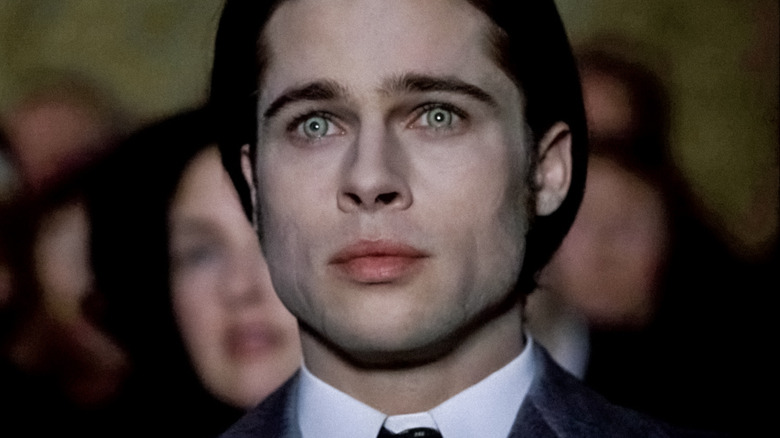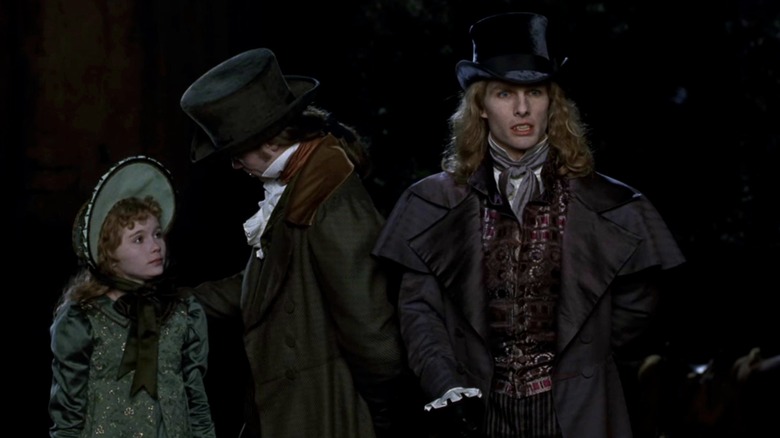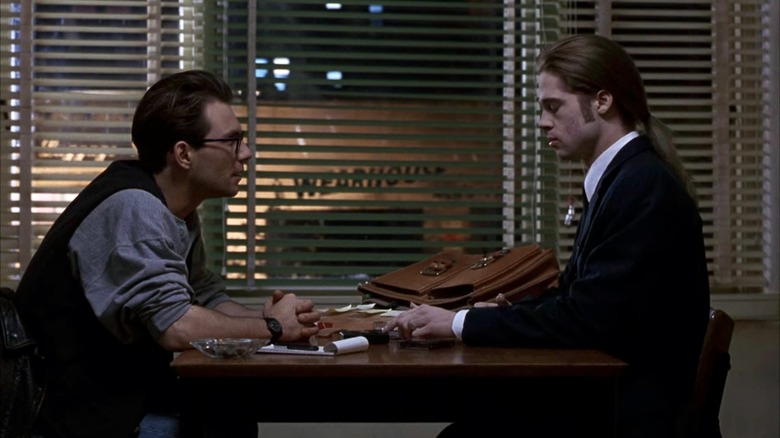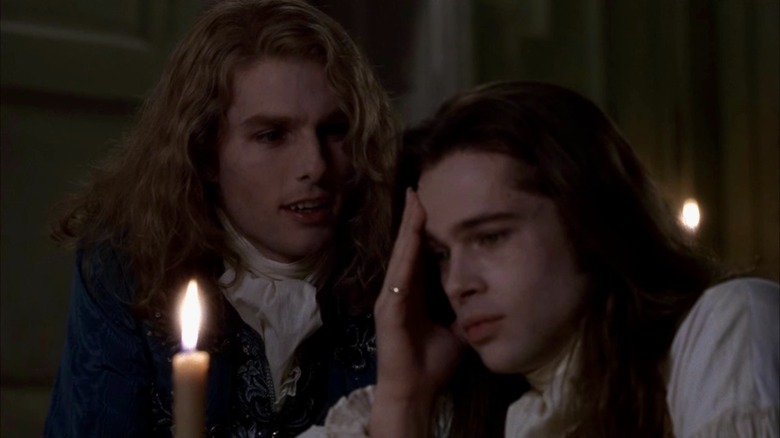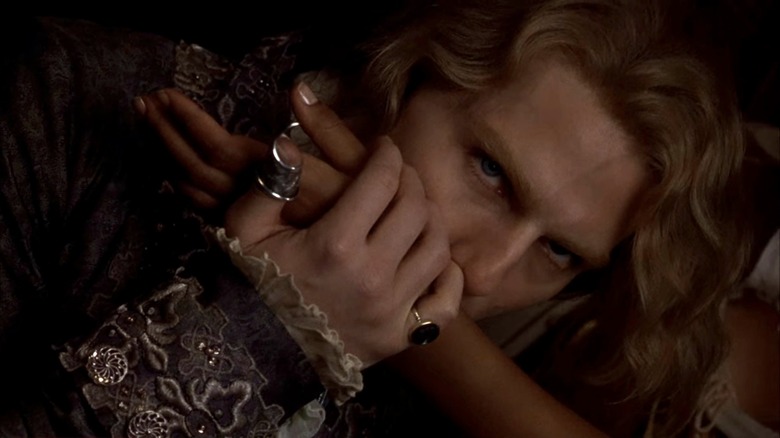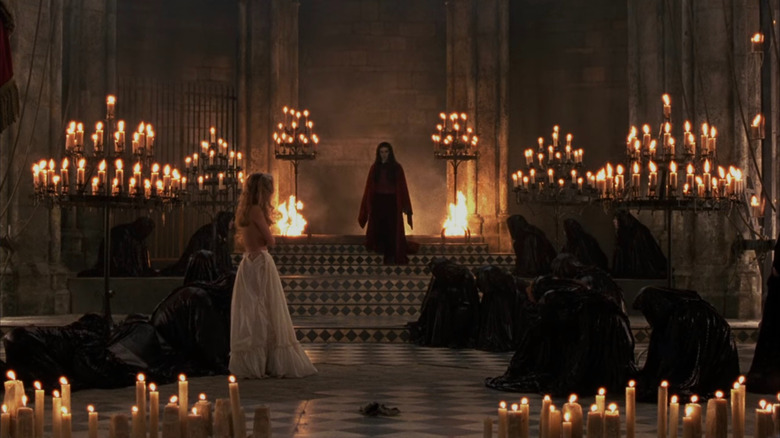Year Of The Vampire: Interview With The Vampire Imbibed The Spirit Of A Lost Century
(Welcome to Year of the Vampire, a series examining the greatest, strangest, and sometimes overlooked vampire movies of all time in honor of "Nosferatu," which turns 100 this year.)
"Interview with the Vampire" begins with a spellbinding orchestration of the Latin burial chant "Libera Me," sung by the American Boy Choir. Toward the end of the movie we see Brad Pitt's undead interviewee, Louis, sitting in a darkened theater, watching scenes from F.W. Murnau's "Sunrise" and "Nosferatu" along with "Gone with the Wind" and "Superman."
"I left the Old World, and came back to my America," Louis narrates. And this is America as he sees it: a place where immortality comes through silver-screen images. Louis calls the world "a graveyard full of broken statues," and as he comes wandering out of the in-film theater in 1988 — a hundred years after the first movie — you have to wonder if his vampire eyes wouldn't see our current franchise-filled ossuary the same way. Quoth Gertrude Stein: "You are all a Lost Generation."
For now, Louis stares in silent awe as Christopher Reeve flies up over the earth in his cape. The hero, a blue beacon for nostalgia, can turn back time by spinning the globe in reverse, and it's as if Neil Jordan's 1994 film adopts a similar point-of-view. Vampire Superman would be one way of describing the ghostly camera perspective that flies in over the Port of San Francisco sign and alights on the street outside a corner hotel room at the beginning of "Interview with the Vampire."
This fluid, three-minute intro — which only features three cuts — isn't in the screenplay, credited to Anne Rice and adapted from her 1976 novel. The screenplay opens with us already in the room where Louis will relate his life story to Christian Slater's interviewer, Molloy.
What it brought to the genre
Vampires and New Orleans: they go together like beignets and café au lait. Except these beignets would be powdered in the dust of human bones — "food for the immortals," as Louis would say. "The wine has no taste" and "life has no meaning" for Louis anymore, but he's not alone in this situation. "Interview with the Vampire" shows Louis and Tom Cruise's Lestat necking as a same-sex vampire couple, who raise an undead girl, Claudia (Kirsten Dunst), as their "little daughter."
It's impossible to overstate Rice's impact on the vampire genre, and for the general moviegoing public, "Interview with the Vampire" distilled her Southern Gothic prose into a film with lush, Oscar-nominated elements: Elliot Goldenthal's score, Dante Ferretti's art direction, and Francesca Lo Schiavo's set direction. Goldenthal was coming off "Alien 3," David Fincher's first film, which musically evokes a cosmos where "there's no meaning ... no spiritualism," as the composer once put it. Louis, the vampire with a human soul who reflects the post-modern age, finds himself adrift in time instead of space, but he feels the same emptiness.
"Interview with the Vampire" saw Rice working through grief over her 6-year-old daughter's death from leukemia. Though Jordan later claimed screenplay credit, much of his film adaptation is lifted directly from Rice's deeply personal novel. With the author having passed away last year, both the book and movie endure as an artifact of her spiritual life. Rice's on-again, off-again relationship with Catholicism ended in a rejection of organized religion, but she clung to her faith, and "Interview with the Vampire" remains a raw emotional outpouring amid her self-described "conversion from a pessimistic atheist lost in a world [she] didn't understand, to an optimistic believer in a universe created and sustained by a loving God."
'Vulgar fictions'
In terms of how it interacts with genre tropes, "Interview with the Vampire" establishes that Louis is "quite fond of looking at crucifixes," and it shows that he can see himself in the mirror — before he smashes it. When he burns down his plantation, it leaves his freed slaves jumping for joy.
Coffins, Louis explains, "are a necessity," but vampires can subsist on the blood of animals, including gators, if need be. Rice undoubtedly romanticizes the undead — their fresh-squeezed rat's blood goes into a proper glass — but Jordan's film adaptation was also instrumental in demystifying them and reframing them as narrators of their own story.
It turns out few of them "have the stamina for immortality," but Louis is a survivor with a tale to tell. He sits down at a table with his human interviewer and dismisses Count Dracula and Transylvanian vampires as "the vulgar fictions of a demented Irishman." Yet he says this right after a flashback depicts him and Claudia embarking on their own Demeter-like voyage to Europe aboard a ship where a "strange plague" strikes the passengers.
The plague has a presence in the streets, too. A man warns Louis, "Don't go that way, monsieur," as he ventures into the sick part of town, where the urchin Claudia awaits him, ready to grow out her goldilocks and channel "Oliver Twist" in a bloodthirsty fashion with the words, "I want some more."
Cruise still takes plenty of chances with the stunts he performs, but "Interview with the Vampire" came at a time when he was taking more chances beyond the action genre with his choice of movie roles. Watching Lestat, this dandy who delights in tormenting his victims ("Evildoers are easier. And they taste better"), it's easy to forget that it's Maverick under that makeup.
The dysfunctional vampire family
Stan Winston handled the vampire makeup and effects for "Interview with the Vampire," and he reportedly had the actors hang upside down like bats so he could trace the blue veins on their forehead better. Rice was famously against Cruise's casting (she backtracked after seeing the movie), but this only caused him to double down and read her books closer to understand his character better.
In the movie, Lestat comes across as a Satanic and Byronic hero. Claudia even calls him the "father of lies." To Louis, his fellow fallen angel, he gives arch pep talks like:
"Evil is a point of view. God kills indiscriminately, and so shall we. For no creatures under God are as we are. None so like him as ourselves."
Louis and Lestat aren't exactly the picture of domestic bliss, and that's kind of the point. For as much as it might be queer-coded, "Interview with the Vampire" is also a movie about the difficulty of living together as a family unit. In the book, it's the loss of his saintly brother — the personification of his faith — that leaves Louis unmoored, guilt-ridden, and wishing for death before he's "born to darkness." He and Lestat share a coffin, the vampire equivalent of a bed, where they sleep one on top of the other.
The movie gives Louis a heteronormative backstory, with a wife and child he lost during childbirth. At one point, Rice even considered making the character a woman, to be played by Cher. By the end of the movie, Louis and Lestat have settled into an acceptance of one another, but they still have a rapport like an old married couple, with the sound of Louis's voice provoking comments from Lestat like, "I've had to listen to that for centuries."
Heaving bosoms
Some of the dialogue in "Interview with the Vampire" is overwrought in a way that calls attention to its literary origins. You can hear the actors struggling to sell certain lines, as if they were tasked with reading the transcript of a novel, which is not so far from what this was.
In an interview with Entertainment Weekly, Pitt lamented how the script — which he received at the last minute — neutered the novelistic Louis and made Lestat "the pulse of the film." Writing Louis circa 1973 allowed Rice to sublimate her grief, but after twenty years of stony sleep in development hell, he had served his purpose and Rice had long since shifted her sympathies to Lestat, the protagonist of her subsequent "Vampire Chronicles."
Onscreen, there are times when Pitt and even the young Dunst seem ill-matched to delivering their characters' po-faced pronouncements. When you have a ten-year-old girl uttering lines like, "Locked together in hatred," it demands a lot of the actor and maybe also the viewer. Yet Claudia is still one of the best evil movie children, and in Pitt and Louis's case, the actor's uncomfortableness in his character's skin arguably suits said character's restless nature. The worldly-wise viewer sees Louis the way Lestat does: as an angst-ridden young man who takes himself too seriously.
Melodrama is the name of the game. "Interview with the Vampire" is a movie with actual heaving bosoms — or at least one that is freckled and heaves as blood pours down from it, soaking through its dress. It's also a movie filled with indelible images, such as the ones inside the Théâtre des Vampires in Paris, where a woman stands naked and vulnerable on stage as "vampires who pretend to be humans pretending to be vampires" surround and menace her.
Théâtre des Vampires
Note how the Théâtre des Vampires audience sits complicit, unable to look away, in "Interview with the Vampire." Scenes like this and the air well, where the sun burns two vampires to ash, have since been parodied on FX's "What We Do in the Shadows," but that only goes to show how memorable and ripe for re-adaptation they are. Louis descends into the catacombs with a scythe and kerosene to enact his fiery revenge, and we share his fury.
You can connect the dots from "Interview with the Vampire" to any number of titles that emerged during the late 2000s and early 2010s vampire craze. Rice, the queen of the genre, said she was a "big fan of 'True Blood'," though she noted how authors like Stephanie Meyer of "Twilight" fame went the opposite direction from her and "domesticated" vampires, putting them in high school and making them more relatable to YA readers. They're still the stuff of romance novels, but they lost some of their Old World charm — the part of them that leapt from New Orleans onto the page and from the page onto the screen, into our eyeballs.
In "Interview of the Vampire," Rice enshrined her daughter's memory with moments like the one where Louis, her fictional alter ego of yore, tells Claudia, "You see the old woman? That'll never happen to you. You will never grow old like her. You will never die." Louis is someone who has lost everything and who rejects anything his final would-be vampire companion, Armand (Antonio Banderas), might have left to offer. When Armand tells him, "I need you to make contact with this age," he speaks for himself and the viewer, who perhaps, like Molloy, draws inspiration from Louis' melancholic tale and comfort from his resilience.
